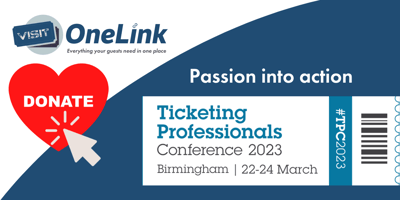VisitOne integrates seamlessly with Tixly to increase secondary revenue, grow your customer...
Arts audiences are ready donate — so how can Theatres go about helping them?
Arts audiences need the right promote to donate...
Arts organisations across the UK and beyond are feeling the pinch with Ticket sales are only part of the picture, and corporate sponsorships often fluctuate. For many venues, it’s individual donations that bridge the gap between keeping the lights on and delivering truly ambitious programming. But getting audiences to donate isn’t always easy.
Recent research from the Advisory Board for the Arts shows that individual giving still makes up at least a third of contributed income for most represented organisations, and for many it’s over half. In the UK it has been reported that while individual donations account for only about 3.5% of overall charitable giving in the UK, they make up a far larger share—averaging 15% of total arts sector income.
So where's the problem? Well the donor pool isn’t growing. Fewer individual gifts are coming from new donors. With traditional appeals bringing in the same loyal supporters but rarely reaching fresh faces, it is not surprising that there is a need for a new approach.
The good news is that audiences are willing—more willing than many venues realise. Data from studies of charitable giving show that under-represented groups, actually give a higher percentage of their income to causes they care about and younger audiences, too, are eager to give, but they want fast, digital and cause-driven options. The desire is there; but so often the infrastructure to channel it isn’t.
Every audience member who passes through your doors could be a donor in the making. Whether they’re the person who booked the tickets, a family member who tagged along, or a colleague invited on a whim, they’ve experienced the magic of live performance. At that moment, they’re not just spectators—they’re potential supporters.
Traditionally, “donor” conjures up an image of someone agreeing to a large amount of financial support or joining a patron circle. Today, the definition needs to be broader. A donor can be someone who adds £10 at checkout, taps to give on their phone as they leave, or dedicates a tribute gift to a loved one. Micro-moments, made simple and accessible, can add up to transformational impact.
Turning Every Ticket Into a Giving Opportunity with VisitOne
So how can arts venues turn these micro-moments of engagement into donations. Three words spring to mind: timing, convenience and VisitOne.
Thinking about the journey of your average theatregoer. They book their tickets weeks in advance. They share them with friends, hopefully via a forwarding process so the venue can capture their data as well. They attend the performance, swept up in the customer experience and the performance. At each of those points, there’s a natural moment for generosity—but traditionally, venues only capture one or two: an annual appeal letter, a capital project campaign, membership renewals or possibly a bucket collection at the exit.
VisitOne can change that equation and the customer experience.
By putting the entire event experience into a digital wallet—tickets, interval drinks, restaurant bookings—it opens a direct line to every attendee, not just the primary booker. That means the friend, the spouse and other attending “shadow-bookers” who usually slip through the cracks—all become reachable. And more importantly, they all become potential donors.
The magic lies in timing. Once a performance ends, why not prompt audiences to donate—at the very moment they’re most emotionally connected to what they’ve just experienced. That’s not an intrusive ask; it’s a continuation of their engagement. Add in options to give in tribute, select specific funds, and tick a box for Gift Aid, and you’ve turned a single night out into a chance to deepen their relationship with your organisation.
Research suggests this approach works. Studies of digital giving platforms show that people respond to emotional framing (“support the theatre you love”) and to choice (“direct your gift to education, access, or artist support”). Recognition matters too: being thanked, even in a simple digital form, makes audiences more likely to give again. VisitOne supports all of these elements natively, without adding friction to the experience.
The bigger picture? Arts fundraising no longer needs to feel like a separate department running on parallel tracks. With VisitOne, giving becomes woven into the audience journey, from ticket to curtain call. And when giving feels like part of the experience, you not only raise more in the moment—you lay the foundation for lasting loyalty.




